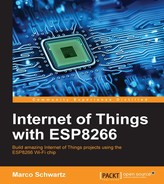In this chapter, we are going to use the ESP8266 to automatically log temperature and humidity measurements in the cloud, and display these measurements inside an online dashboard.
By following this project, you will be able to build a small and cheap measurement platform that logs data in the cloud. Of course, this can be applied to several types of sensor, such as motion detectors. Let's dive in!
For this project, you will need the following hardware:
- Of course you need an ESP8266 chip. You can, for example, use an Olimex ESP8266 module.
- You will also need a temperature sensor. I used a DHT11 sensor, which is very easy to use and will allow us to measure the ambient temperature and humidity.
- You will also need a 3.3V FTDI USB module to program the ESP8266 chip. Finally, you will also need some jumper wires and a breadboard.
This is a list of all the components that will be used in this chapter, along with the sources where you can purchase them:
- ESP8266 Olimex module (https://www.olimex.com/Products/IoT/MOD-WIFI-ESP8266-DEV/open-source-hardware)
- Breadboard 3.3V power supply (https://www.sparkfun.com/products/13032)
- 3.3V FTDI USB module (https://www.sparkfun.com/products/9873)
- DHT11 sensor (https://www.adafruit.com/products/386)
- Breadboard (https://www.sparkfun.com/products/12002)
- Jumper wires (https://www.sparkfun.com/products/9194)
On the software side, you will need:
- The latest version of the Arduino IDE, which you can get from: http://www.arduino.cc/en/Main/Software.
Now let's follow this procedure to add the ESP8266 board to the Arduino IDE:
To install an Arduino library:
- First, download the library from the GitHub repository.
- Then, go into the Arduino IDE, and navigate to Sketch | Include Library | Add .ZIP Library.
- Finally, select the file that you just downloaded.
..................Content has been hidden....................
You can't read the all page of ebook, please click here login for view all page.
